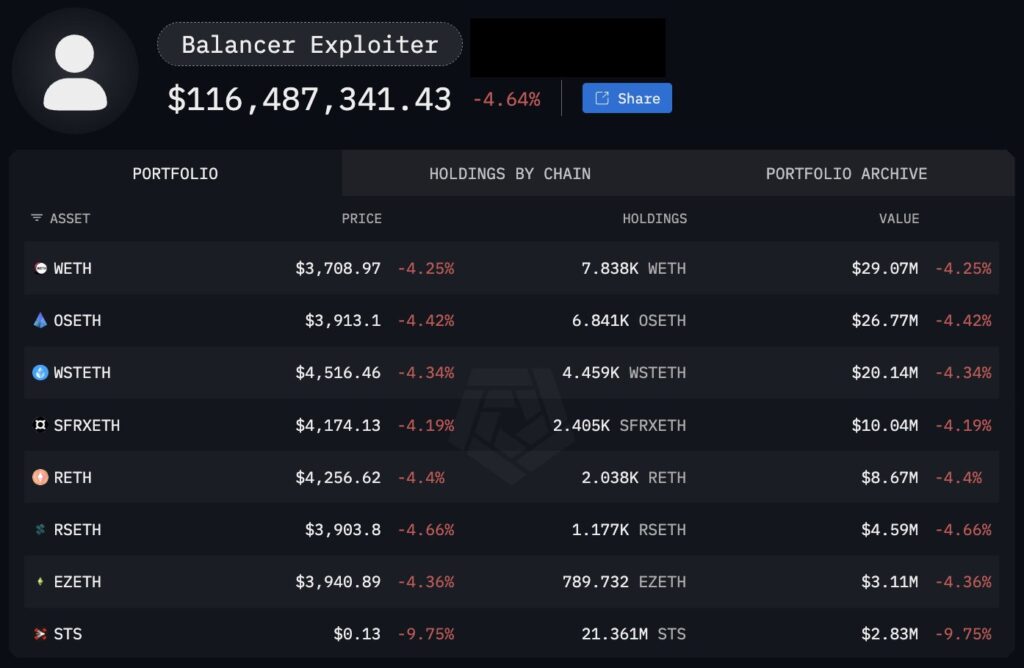Major Balancer Hack: A Heist of Over $129 Million in Crypto Assets
On November 3, 2025, the decentralized finance (DeFi) protocol Balancer succumbed to a significant exploit, resulting in the loss of more than $129 million in crypto assets. The attack primarily targeted Balancer’s V2 pools and vaults, impacting a variety of chains including Ethereum, Base, and Berachain. Following the incident, Balancer’s engineering and security teams initiated an investigation, highlighting the ongoing risk within the DeFi sector and the need for enhanced security measures to protect user assets.
Understanding the Exploit: How It Happened
PackShieldAlert, a blockchain security firm, reported that the exploit was characterized by hackers converting liquid staking tokens (LSTs), such as WETH, osETH, wstETH, sfrxETH, and rsETH, into ETH in real-time. The exploit involved manipulating Vault calls during the initialization process, taking advantage of improper authorizations and callback handling that enabled unauthorized swaps or balance manipulations. On-chain investigators detected that a maliciously deployed contract exploited these vulnerabilities to drain assets across multiple interconnected pools, sending shockwaves through the crypto community.
Multi-Chain Impact: Affected Networks
The repercussions of the Balancer hack have rippled across several networks. According to Spot On Chain data, affected chains include Ethereum, Base, Optimism, Sonic, Polygon, and Berachain. Notably, a dormant whale address, 0x009, was activated soon after the hack, removing assets valued at $7.38 million from Balancer. This move intensified concerns over the hack’s implications not only for Balancer but also for the security protocols of other decentralized finance platforms.
Immediate Reactions: Bera Validators Take Action
In response to the exploit, the Berachain network validators executed a deliberate halt of the chain. The Bera Foundation announced an emergency hard fork to address Balancer V2-related vulnerabilities. Communication on social media described the proactive measures; the Ethena team was contacted to disable bridging out of Bera, pause lending markets, and ensure all affected addresses were blacklisted. This action exemplifies the growing recognition among DeFi networks of the need for agility and quick responses to security threats.
Market Reactions: Crypto Prices Plummet
The financial fallout from the exploit was immediate, as shown by the plummeting prices of affected tokens. The BAL token saw a dramatic drop of over 10%, trading at approximately $0.897, while the BERA token declined by 7%, settling at $1.69. Trading volumes for both tokens surged, suggesting heightened market volatility and investor anxiety. Liquid staking tokens such as LDO, JTO, and RPL also experienced significant drops, reinforcing the negative investor sentiment following the exploit. Furthermore, Ethereum’s price fell over 4% within 24 hours, indicating the widespread market implications of the hack.
Lessons Learned and Future Precautions
The Balancer hack serves as a sobering reminder of the vulnerabilities present in decentralized finance ecosystems. As the DeFi landscape continues to grow, the importance of secure coding practices, rigorous audits, and responsive governance cannot be overstated. Developers and security teams must remain vigilant and proactive in identifying potential weaknesses before malicious actors can exploit them. Additionally, the community must push for greater transparency and accountability within these platforms to ensure user confidence in the safety of their assets.
In conclusion, while the Balancer hack has resulted in significant losses and instigated urgent responses, it is also a pivotal moment for the DeFi landscape to reassess its security measures and protocols. Ensuring the safety of user assets in an ever-evolving space will require continuous effort and innovation, allowing users to navigate the DeFi world with greater confidence in the integrity of the platforms they interact with.


